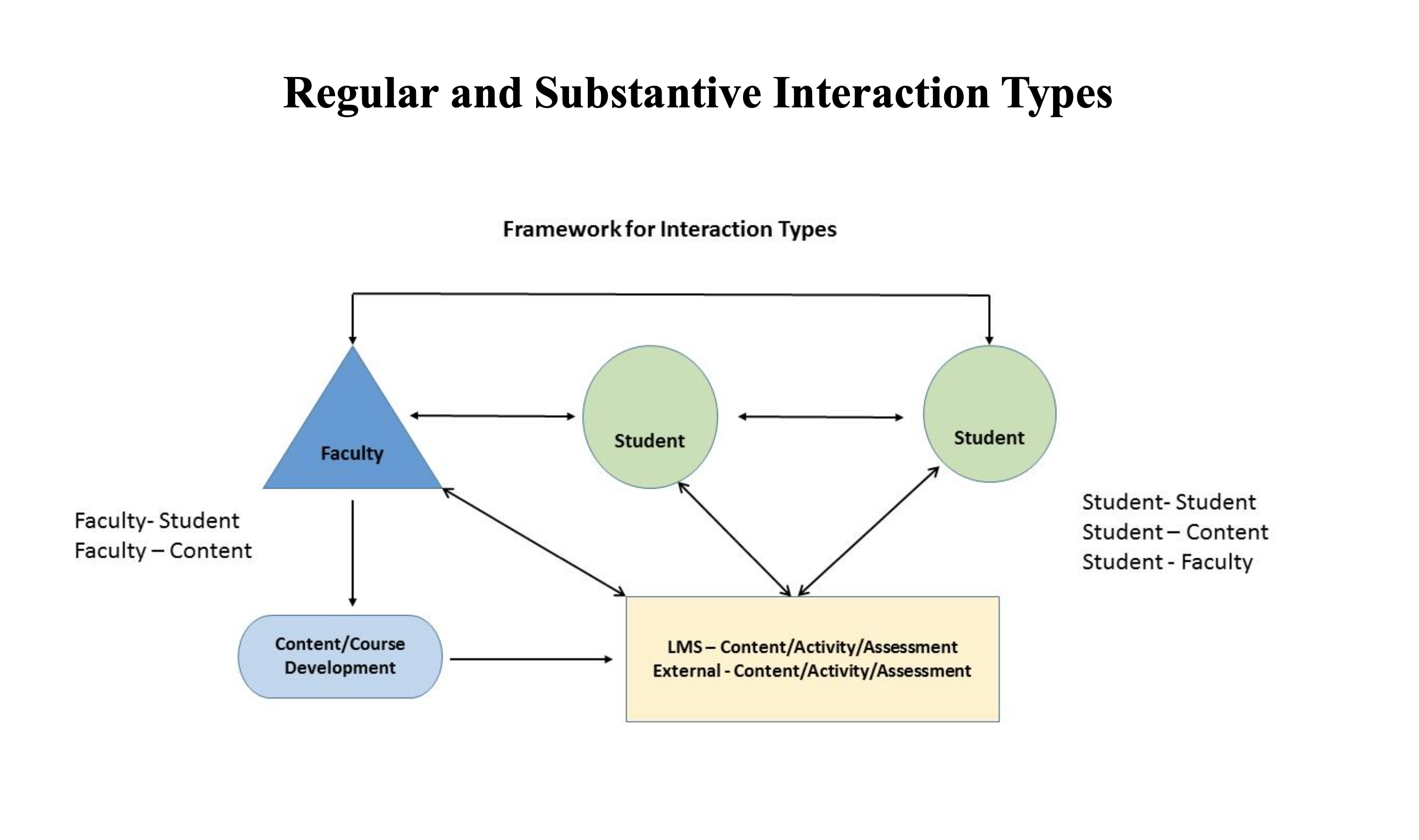To ensure students have an engaging learning experience, faculty are encouraged to include a variety of interaction types in their course design. Interaction types include student-to-student, faculty-to-student, and student-to-course content.
Faculty can leverage many tools within Canvas to facilitate essential interactions in a course. Some common elements of interaction include the following:
- Synchronous interactions that support the direct and real-time interactions between individuals
- Asynchronous interactions that support the indirect interactions between individuals
- Student-to-student initiated or led interactions
- Student interaction with course-related content
- Faculty initiated or led interactions
Interaction type + tool type Examples
Tool Type
- Email to students
- Announcements
- VoiceThread
- Discussion Boards
- Journal Entries
- Assignments (papers, reports, projects, etc.)
- Panopto
- Zoom
- Phone
- Gradebook
Interaction / activity examples
1. Responding to student emails about course content. (Asynchronous modality)
2. Summarizing the results or insights from the previous weeks activities and describing the coming weeks activities, expectations and deadlines. (Asynchronous modality)
3. Posting an initial prompt and/or example for students to model. Encouraging further discussion by asking students to clarify or elaborate on responses. (Asynchronous modality)
4. Monitoring and moderating the discussion forums. A moderator does not respond to all postings in a forum. Rather, a moderator helps guide the discussions based on selected responses or responses to the entire group. (Asynchronous modality)
5. Providing feedback regarding what a student does well in addition for pointing out specific areas for improvement, clarification, or deeper critical thinking. (Asynchronous modality)
6. Providing feedback regarding what a student does well in addition for pointing out specific areas for improvement, clarification or deeper critical thinking. (Asynchronous modality)
7. Providing faculty introduction, course overview/navigation, and lecture videos. (Asynchronous modality)
8. Providing opportunities for students to communicate directly with faculty at defined times during a week. A best practice would be to hold office hours using Zoom and to record the sessions if appropriate to be watched by students unable to attend. For example, questions being asked in preparation for a test or an assignment. (Asynchronous modality)
9. Providing opportunities for students to communicate directly with faculty via phone (Synchronous modality)
10. Including thoughtful feedback on various assessments that prompt the student to reflect and expand his or her knowledge. Feedback should promote additional critical thinking and suggest opportunities for improvement as well as identify what a student has done successfully. (Asynchronous modality)
Tool type
- Blog posts
- Discussion Boards
- Wikis
- Group Projects
- VoiceThread
- Zoom
Interaction / activity examples
1. Initial posts and responses to peers (Asynchronous modality)
2. Initial posts and responses to peers (Asynchronous modality)
3. Initial posts and responses to peers (Asynchronous modality)
4. Collaborative work toward end goal of the project (Synchronous or
Asynchronous modality)
5. Presentations and comments, introductions (Asynchronous modality)
6. Group meetings, study sessions, live lectures (Asynchronous modality)
For any assessment, faculty should provide students with a rubric or an expectation of work submitted.
Tool Type
- Textbook, articles, written content on LMS
- Video/audio content (lectures, supplementary videos)
- Labs
- Research for labs, papers, projects, etc.
- Quizzes, tests, surveys
- Assignments
- Discussion Boards
Interaction / activity examples
1. Reading assigned content either from textbooks, articles, content on the LMS, etc. (Asynchronous modality)
2. Watching/listening to video or audio content including instructor-produced lectures, podcasts, supplementary videos, etc. (Either, depending upon the requirements of the instructor)
3. Preparing for and participating in labs. (Either, depending upon the requirements of the instructor)
4. Conducting supplementary research in preparation for labs, papers, projects, presentations, etc. (Asynchronous modality)
5. Completing quizzes, tests or surveys tied to course content. (Either, depending upon the requirements of the instructor)
6. Completing assignments tied to course content. (Asynchronous modality)
7. Responding to discussion board prompts related to course content. (Asynchronous modality)

